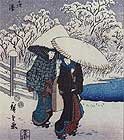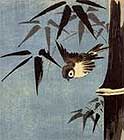

Tales
of Old Japan
by Algernon Bertram Freeman-Mitford
The Loves of Gompachi and Komurasaki
A
Story of the Otokodate of Yedo
The Wonderful Adventures of Funakoshi Jiuyemon
The Eta Maiden and the Hatamoto
The
Accomplished and Lucky Tea-Kettle
The Story of the Old Man Who Made Withered Trees to Blossom
The Battle of the Ape and the Crab
The Adventures of Little Peachling
The History of Sakata Kintoki
The Elves and the Envious Neighbour
How Tajima Shume Was Tormented By a Devil of His Own Creation
Concerning Certain Superstitions
How a Man Was Bewitched and Had His Head Shaved By the Foxes
The History of Sakata Kintoki
A LONG time ago there was an officer of the Emperor's body-guard, called Sakata Kurando, a young man who, although he excelled in valour and in the arts of war, was of a gentle and loving disposition. This young officer was deeply enamoured of a fair young lady, called Yaégiri, who lived at Gojôzaka, at Kiyôto. Now it came to pass that, having incurred the jealousy of certain other persons, Kurando fell into disgrace with the Court, and became a Rônin, so he was no longer able to keep up any communication with his love Yaégiri; indeed, he became so poor that it was a hard matter for him to live. So he left the place and fled, no one knew whither. As for Yaégiri, lovesick and lorn, and pining for her lost darling, she escaped from the house where she lived, and wandered hither and thither through the country, seeking everywhere for Kurando.
Now Kurando, when he left the palace, turned tobacco merchant, and, as he was travelling about hawking his goods, it chanced that he fell in with Yaégiri; so, having communicated to her his last wishes, he took leave of her and put an end to his life.
Poor Yaégiri, having buried her lover, went to the Ashigara Mountain, a distant and lonely spot, where she gave birth to a little boy, who, as soon as he was born, was of such wonderful strength that he walked about and ran playing all over the mountain. A woodcutter, who chanced to see the marvel, was greatly frightened at first, and thought the thing altogether uncanny; but after a while he got used to the child, and became quite fond of him, and called him "Little Wonder," and gave his mother the name of the "Old Woman of the Mountain."
One day, as "Little Wonder" was playing about, he saw that on the top of a high cedar-tree there was a tengu's nest;58 so he began shaking the tree with all his might, until at last the tengu's nest came tumbling down.
As luck would have it, the famous hero, Minamoto no Yorimitsu, with his retainers, Watanabé Isuna, Usui Sadamitsu, and several others, had come to the mountain to hunt, and seeing the feat which "Little Wonder" had performed, came to the conclusion that he could be no ordinary child. Minamoto no Yorimitsu ordered Watanabé Isuna to find out the child's name and parentage. The Old Woman of the Mountain, on being asked about him, answered that she was the wife of Kurando, and that "Little Wonder" was the child of their marriage. And she proceeded to relate all the adventures which had befallen her.
When Yorimitsu heard her story, he said, "Certainly this child does not belie his lineage. Give the brat to me, and I will make him my retainer." The Old Woman of the Mountain gladly consented, and gave "Little Wonder" to Yorimitsu; but she herself remained in her mountain home. So "Little Wonder" went off with the hero Yorimitsu, who named him Sakata Kintoki; and in aftertimes he became famous and illustrious as a warrior, and his deeds are recited to this day. He is the favourite hero of little children, who carry his portrait in their bosom, and wish that they could emulate his bravery and strength.
The text came from:
Freeman-Mitford,
A. B. Tales of Old Japan. London: Macmillan, 1871, 1890.
Amazon.com:
Buy the book in paperback.
FOOTNOTES
Footnote 58:Tengu, or the Heavenly Dog, a hobgoblin who infests
desert places, and is invoked to frighten naughty little children.
Return to place in text.
©Heidi
Anne Heiner, SurLaLune Fairy Tales
E-mail: surlalune@aol.com
Page last updated June 1, 2005
www.surlalunefairytales.com







